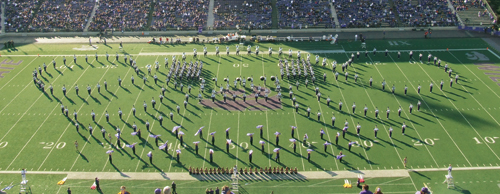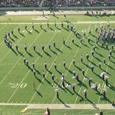
We asked our experts about the best way to clean curved lines in drill. Here are their responses.
For the first several years of my career I taught drill the way I was taught: somebody, (the director, a section leader, or a staff member) told each student where to stand, and then students marked with paint, a poker chip, a wallet, or a hole in the dirt. This was followed by the director repeatedly instructing the band to dress the form.
I spent a tremendous amount of time talking to students about making sure that they were spaced equally from each other, showing them how to line up body parts (“make sure your left elbow is even with his right clavicle”), and then endlessly adjusting and readjusting the forms throughout the season. Some years everybody in the band received full drill charts and sometimes only the officers and staff did, but the general principle was always the same – close enough is good enough.
When I arrived at the University of South Florida it quickly became apparent that this method was not going to work, there was not enough time to learn and clean drill for multiple shows using the “get close” method. Several staff members convinced me to pass out dot books instead of drill charts, and the results have been fantastic. In this system each student gets one sheet of paper that lists assigned coordinates for every picture. Drill design software can produce these sheets with a simple click of a button, and as an added bonus, it saves a tremendous amount of paper compared to passing out full charts to every student. After students are taught how to decipher what each coordinate means it takes them little time to set each picture. Also, rather than trying to remember which poker chip or hole in the ground belongs to whom, they know exactly where they are supposed to end up.
Many drum corps and college and high school bands have been using dot charts for years. I had long been skeptical because I thought that the ability to stay in the picture was more important than hitting the exact spot on the page. I am now a complete convert. Rather than asking students to simply fit into a form – possibly paving way for a whole slew of marchers to be wrong – it puts responsibility on each person to know exactly where the spot is, thus making large mistakes far less likely.
Therefore, I would answer the question about getting the curved lines right exactly as I would about how to get diagonals, vertical, or horizontal lines clean. Make sure the students know that they alone are responsible for hitting the spot that is designated to them. This works for bands of all sizes, ages, and ability levels. High school freshmen are every bit as capable of doing this as are college seniors.
– Matthew McCutchen
The University of South Florida
The secret is to set the curve, then have the students hold up their instruments in playing position and memorize what they can see – how far behind and off to the side they are from the person in front of them. Students must set based off of the people in front of them, and the people at the very front have to set off of the sideline or hash marks. The whole idea is that they should be able to set the curve even if there were no lines on the field, because they are setting off of each other as opposed to a spot on the field. Additionally, circle drills during marching basics really help students get used to keeping proper intervals in curves.
– Daniel A. Kiene
Richmond Hill High School
Richmond Hill, Georgia
Students should know their spot in the drill and make every effort to arrive correctly every time. Tape, chalk, spray paint can be used as this will help with muscle memory. In addition, students should fight the tendency to look down; keeping their heads up will force students to learn their paths and have a consistent step size and angle. Awareness of their responsibility within the form and the space between them and their neighbors will create cleaner forms.
After each drill set, students should adjust with horns down. When the form is correct, have them put up horns so students can see how the form looks from their vantage point. This is important for giving students a reference to what they should see while marching.
After some time, the dot system should be dropped and students should start relying on dressing to the form. Many times students will go to their spot even if this puts them out of the form. This should be avoided.
The circle drill can be extremely beneficial when learning spatial awareness.
– Raquel Rodriquez
Northern Kentucky University





